外研版高中英语选择性必修第一册Unit5 Revealing nature PeriodⅢ Developing ideas & Presenting ideas课件
文档属性
| 名称 | 外研版高中英语选择性必修第一册Unit5 Revealing nature PeriodⅢ Developing ideas & Presenting ideas课件 | 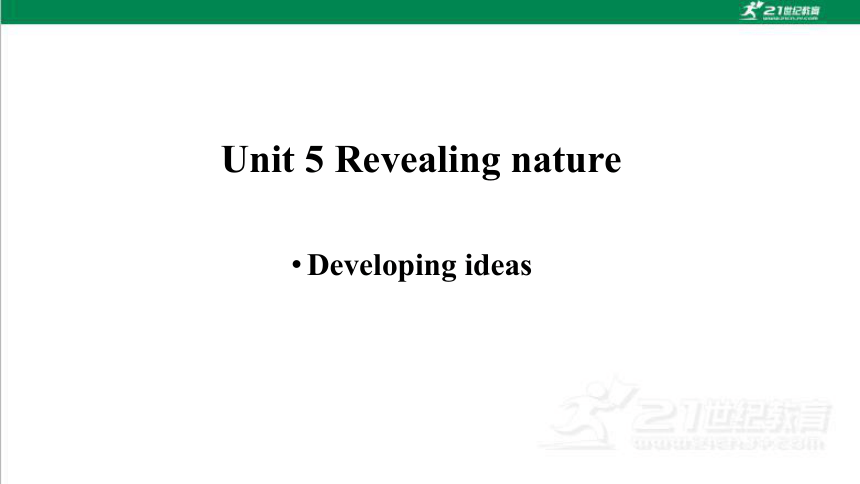 | |
| 格式 | ppt | ||
| 文件大小 | 5.9MB | ||
| 资源类型 | 试卷 | ||
| 版本资源 | 外研版(2019) | ||
| 科目 | 英语 | ||
| 更新时间 | 2025-08-06 16:10:24 | ||
图片预览

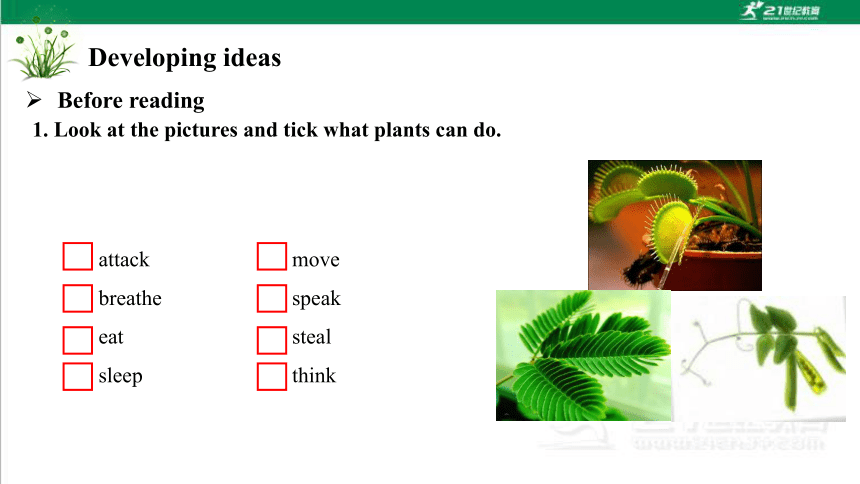
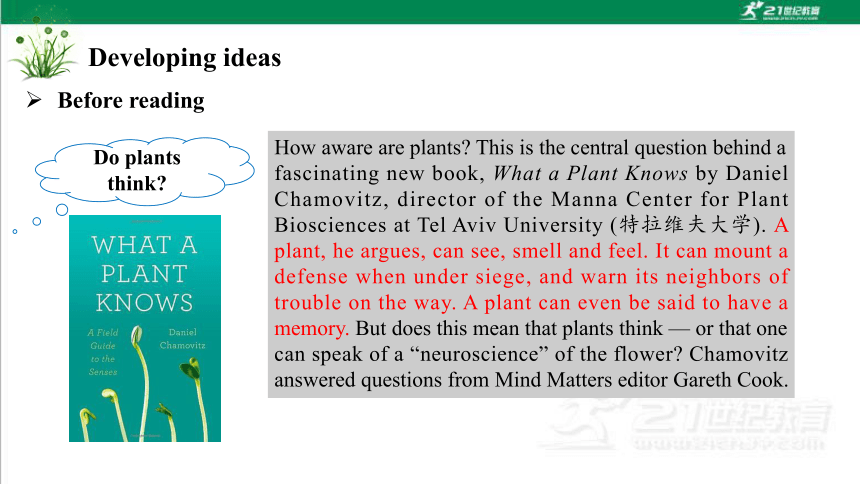
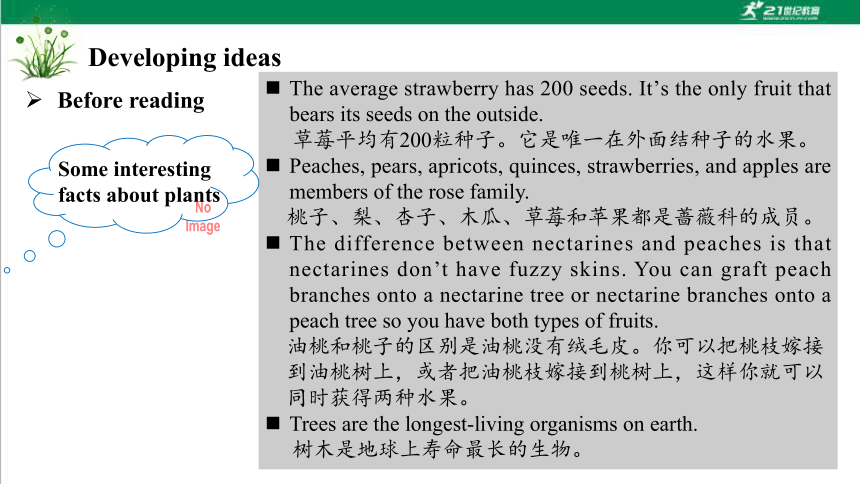
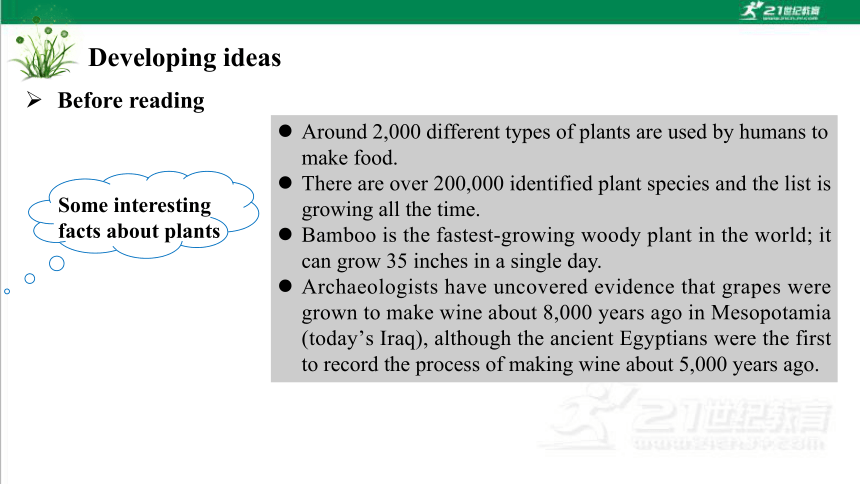
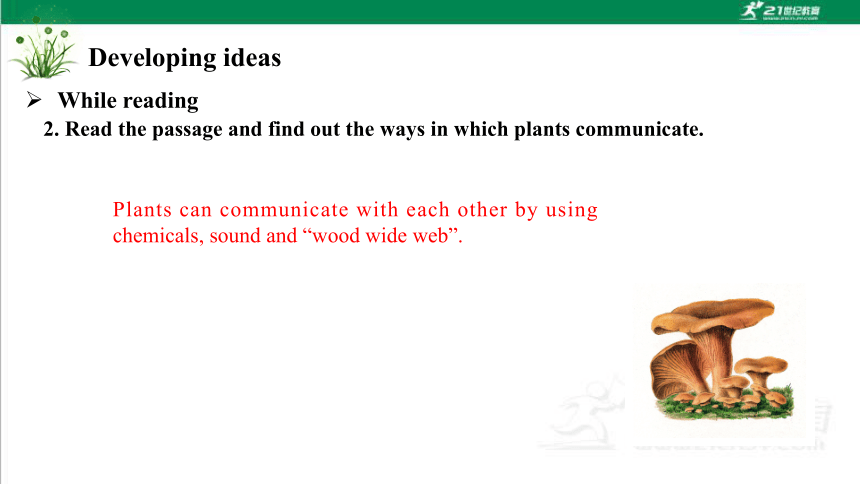
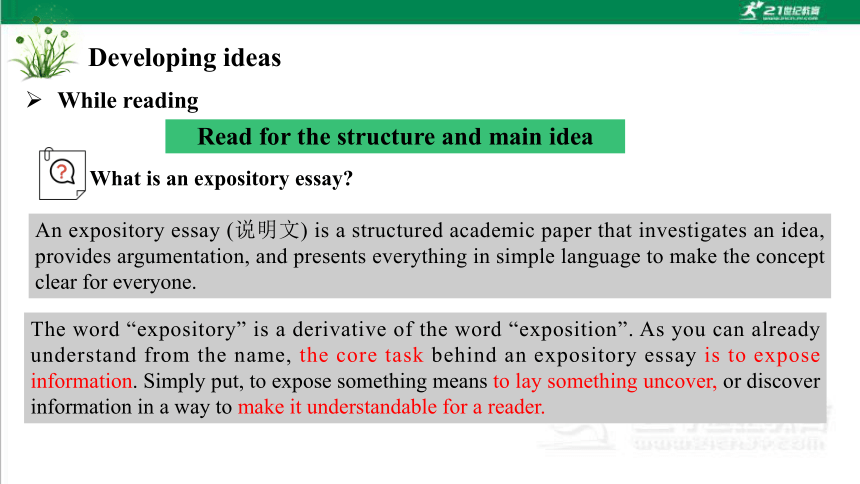
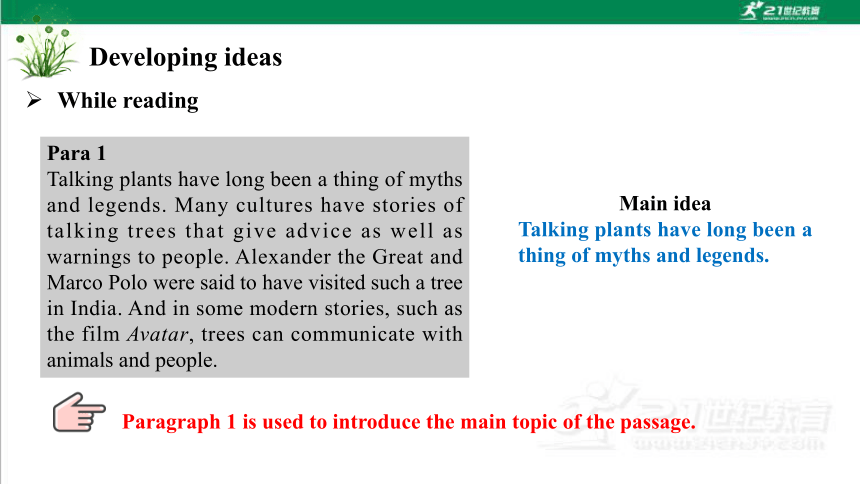
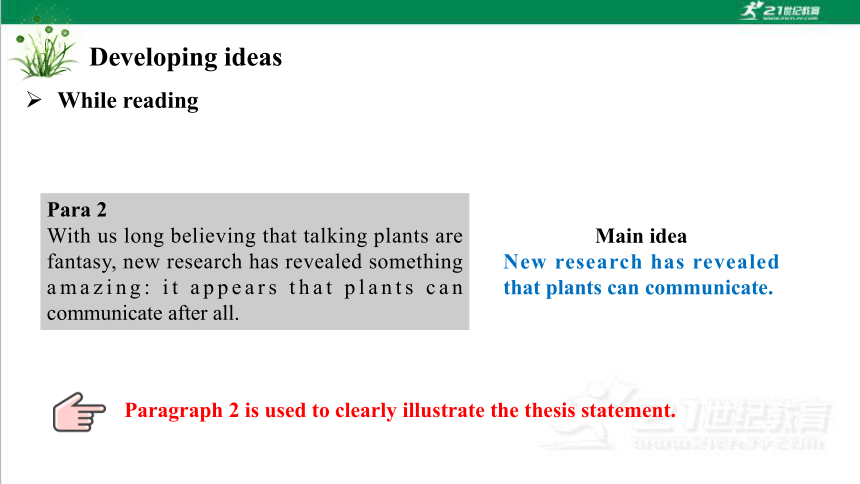
文档简介
(共24张PPT)
Unit 5 Revealing nature
Developing ideas
attack move
breathe speak
eat steal
sleep think
1. Look at the pictures and tick what plants can do.
Developing ideas
Before reading
How aware are plants This is the central question behind a fascinating new book, What a Plant Knows by Daniel Chamovitz, director of the Manna Center for Plant Biosciences at Tel Aviv University (特拉维夫大学). A plant, he argues, can see, smell and feel. It can mount a defense when under siege, and warn its neighbors of trouble on the way. A plant can even be said to have a memory. But does this mean that plants think — or that one can speak of a “neuroscience” of the flower Chamovitz answered questions from Mind Matters editor Gareth Cook.
Do plants think
Developing ideas
Before reading
The average strawberry has 200 seeds. It’s the only fruit that bears its seeds on the outside.
草莓平均有200粒种子。它是唯一在外面结种子的水果。
Peaches, pears, apricots, quinces, strawberries, and apples are members of the rose family.
桃子、梨、杏子、木瓜、草莓和苹果都是蔷薇科的成员。
The difference between nectarines and peaches is that nectarines don’t have fuzzy skins. You can graft peach branches onto a nectarine tree or nectarine branches onto a peach tree so you have both types of fruits.
油桃和桃子的区别是油桃没有绒毛皮。你可以把桃枝嫁接
到油桃树上,或者把油桃枝嫁接到桃树上,这样你就可以
同时获得两种水果。
Trees are the longest-living organisms on earth.
树木是地球上寿命最长的生物。
Some interesting facts about plants
Developing ideas
Before reading
Around 2,000 different types of plants are used by humans to make food.
There are over 200,000 identified plant species and the list is growing all the time.
Bamboo is the fastest-growing woody plant in the world; it can grow 35 inches in a single day.
Archaeologists have uncovered evidence that grapes were grown to make wine about 8,000 years ago in Mesopotamia (today’s Iraq), although the ancient Egyptians were the first to record the process of making wine about 5,000 years ago.
Some interesting facts about plants
Developing ideas
Before reading
2. Read the passage and find out the ways in which plants communicate.
Plants can communicate with each other by using chemicals, sound and “wood wide web”.
Developing ideas
While reading
An expository essay (说明文) is a structured academic paper that investigates an idea, provides argumentation, and presents everything in simple language to make the concept clear for everyone.
Read for the structure and main idea
The word “expository” is a derivative of the word “exposition”. As you can already understand from the name, the core task behind an expository essay is to expose information. Simply put, to expose something means to lay something uncover, or discover information in a way to make it understandable for a reader.
What is an expository essay
Developing ideas
While reading
Para 1
Talking plants have long been a thing of myths and legends. Many cultures have stories of talking trees that give advice as well as warnings to people. Alexander the Great and Marco Polo were said to have visited such a tree in India. And in some modern stories, such as the film Avatar, trees can communicate with animals and people.
Main idea
Talking plants have long been a thing of myths and legends.
Developing ideas
Paragraph 1 is used to introduce the main topic of the passage.
While reading
Para 2
With us long believing that talking plants are fantasy, new research has revealed something amazing: it appears that plants can communicate after all.
Main idea
New research has revealed that plants can communicate.
Developing ideas
Paragraph 2 is used to clearly illustrate the thesis statement.
While reading
Para 3
It has been known for some time that plants use chemicals to communicate with each other. This happens when a plant, say a bean plant, gets attacked by insects. The plant releases tiny amounts of chemicals from the leaves that are being eaten. This is like a warning, or a call for help: “I”m being attacked!” When another bean plant detects the chemicals from its injured neighbour, it starts to release its own, different chemicals. Some of these chemicals drive insects away. Others attract insects—the wasps! The wasps kill the insects that are eating the bean plants. Scientists hope to learn more about this plant warning system, so that we can use it to grow crops without pesticides.
Main idea
It has been known for some time that plants use chemicals to communicate with each other.
Developing ideas
Paragraph 3 is Point 1: Using chemicals.
While reading
Main idea
Plants also use sound
to communicate.
Para 4
More surprisingly, plants also use sound to communicate. People can’t hear these sounds, but plants are making them. Some plants make noises with their roots. Corn and chilli plants do this. They also “listen” to the noises from other plants. A chilli plant can tell if a neighbouring plant is helpful, or unfriendly. Some trees make clicking noises when there is not enough water, indicating drought is arriving.
Developing ideas
Paragraph 4 is Point 2: Using sound.
While reading
Main idea
Plants have a
communication system called “wood wide web” in a forest.
Para 5
Most surprisingly of all, plants have an amazing system of communication that can link nearly every plant in a forest. Scientists call this system the “wood wide web”. It is in some ways similar to the Internet we use. While the Internet is a worldwide network of computers linked by cables and satellites, the wood wide web is linked underground by fungi. This fungal network links the roots of different plants to each other. Using the wood wide web, plants can share information and even food with each other. For example, some pine trees can send food to smaller pine trees to help them grow. But just like our own Internet, the wood wide web has its own version of “cybercrime”. Plants can steal food from each other, or spread poisons to attack other plants. Perhaps one day scientists will learn how to create a “firewall” to help prevent these attacks within the wood wide web.
Developing ideas
Paragraph 5 is Point 3: Using the “wood wide web” .
While reading
Main idea
Scientists are learning more about the secret language of plants.
Para 6
Scientists are learning more every day about the secret ways in which plants talk to each other. Who knows Maybe one day we will know enough about plant communication to be able to “talk” with them ourselves.
Developing ideas
Paragraph 6 is used as a conclusion and a restatement.
While reading
Part 1: Introduction and thesis statement
Para.1-2: Plants can communicate.
Part 2: Body
Para. 3-5: Plants have various ways to communicate.
Part 3: Conclusion
Para. 6: Scientists are learning more about the
language of plants.
Developing ideas
Organization
of the passage
While reading
Using chemicals
* The plant releases chemicals ____________ that are being eaten.
* When another plant detects the chemicals, it starts to ______________
____________________.
from the leaves
release its own, different chemicals
Using sound
* Some plants make noises _____________________.
* A chilli plant can __________
__________________________
__________________________.
* Some trees make ___________
__________________________.
with their roots
tell if a
neighbouring plant is
helpful, or unfriendly
clicking noises
to indicate drought’s coming
Using the “wood wide web”
* This fungal network links _____ ____________________________.
* Plants can __________________
_____________ with each other.
* Plants can __________________
_____________________ to attack other plants.
the roots
of different plants to each other
share information
steal food from each other
Developing ideas
Modern research is showing that plants can __________________________.
Maybe one day we will be able to “talk” with plants.
communicate with each other
3. Organise information from the passage and complete the diagram.
and even food
or spread poisons
While reading
Developing ideas
What figure of speech is being used when the plants are described as calling for help What is its function
What does “wood wide web” mean
What do you think are the benefits of studying plant communication
What discoveries are described in the two reading passages in this unit and what do their meanings have in common
Think share
Personification. It can make descriptions more vivid.
“Wood wide web” means an amazing system of communication that can link nearly every plant in a forest. It is linked underground by fungi and this fungal network links the roots of different plants to each other. Using the wood wide web, plants can share information and even food with each other.
Passage 1 reveals the discovery of evolution and Passage 2 reveals the discovery of communication between plants. They all reflect that there are numerous secrets in nature that remain to be explored.
While reading
Passage 1 reveals the discovery of evolution and Passage 2 reveals the discovery of communication between plants. They all reflect that there are numerous secrets in nature that remain to be explored.
1. Talking plants have long been a thing of myths and legends.
Talking plants即“会说话的树”,talking 为现在分词作定语,它与所修饰的名词之间存在逻辑上的主谓关系,可以替换成一个定语从句,即Plants that talk。
【拓展】单个分词作定语时,通常放在被修饰的名词之前;分词短语作定语时,放在被修饰的名词之后。
现在分词作前置定语,通常表示正在进行的主动动作,也可以表示主动但不是正在进行的动作。
过去分词作前置定语,通常表示被动,且有时有已完成的含义。
Developing ideas
After reading — key words and expressions
【例句】
A falling body is accelerated by the attraction of the earth.(单个分词,前置)
The cinema standing across the street was set up last year.(分词短语,后置)
The injured man was rushed to the hospital.(单个分词,前置)
Most of the young men invited to the party were Jack’s classmates.(分词短语,后置)
a sleeping child, a falling star(主动,正在进行)
a promising child, a walking dictionary(主动,但不是正在进行)
fried eggs, boiled water(被动完成)
Developing ideas
1. Talking plants have long been a thing of myths and legends.
After reading — key words and expressions
2. Alexander the Great and Marco Polo were said to have visited such a tree in India. And in some modern stories, such as the film Avatar, trees can communicate with animals and people.
【例句】
据说 Darwin是《物种起源》一书的作者。
Darwin is said to be the writer of the book On the Origin of Species.
=It is said that Darwin is the writer of the book On the Origin of Species.
=People say (that) Darwin is the writer of the book On the Origin of Species.
sb be said to do sth结构的含义和用法:
sb be said to do sth = It is said that sb do sth = people say (that) sb do sth“据说某人做了某事”。
Developing ideas
After reading — key words and expressions
3. With us long believing that talking plants are fantasy, new research has revealed something amazing: it appears that plants can communicate after all.
With us long believing that talking plants are fantasy复合结构在句中作状语,说明背景。现在分词believing和前面的代词是逻辑上的主谓关系,表示主动。
【拓展】在“with+名词/代词+非谓语动词”复合结构中,非谓语动词可以是不定式(多指动作尚未发生)、动词-ing形式(多指动作正在进行)、动词-ed形式(与前面的名词构成被动关系)。
Developing ideas
【例句】
With Tim guiding us, we had no difficulty in finding the destination. 由于Tim的引导,我们毫不费力地找到了目的地。
With no one to talk to, John felt miserable. 没有人可以倾诉,约翰感到很难受。
With the problem settled, he felt relieved. 问题解决了,他如释重负。
After reading — key words and expressions
4. This happens when a plant, say a bean plant, gets attacked by insects.
Developing ideas
say在这里意为“认为;假定,比方说”。
【拓展】常用的表达还有:let’s say (that) 和just say (that)。
【例句】
If we put out, say, twenty chairs, would that be enough 如果我们搬出去,比方说二十把椅子,够不够?
Let’s say your plan fails, then what 假设说你的计划失败,那怎么办?
Just say you won the lottery — what would you do 假定你中了彩票——你打算做什么?
After reading — key words and expressions
5. When another bean plant detects the chemicals from its injured neighbour, it starts to release its own, different chemicals.
Developing ideas
detect v. 发现,察觉(尤指不易察觉到的事物)
detection n. 察觉,发现;侦查
detectable adj. 可觉察的;可发现的;可查出的
【例句】
The tests are designed to detect the disease early. 这些检查旨在早期查出疾病。
Many problems, however, escape detection. 然而许多问题却未被察觉。
The noise is barely detectable by the human ear. 这种噪音人的耳朵几乎是察觉不到的。
After reading — key words and expressions
6. Scientists call this system the “wood wide web”. It is in some ways similar to the Internet we use. While the Internet is a worldwide network of computers linked by cables and satellites, the wood wide web is linked underground by fungi.
Developing ideas
wood wide web 源于互联网词汇 world wide web。
注意作者的造词手法:作者运用wood wide web,在形式和功能上将两者巧妙地联系起来,从而帮助学生进一步了解这种神奇的植物信息网络。语言生动,比喻恰当,贴近生活。
After reading — key words and expressions
7. While the Internet is a worldwide network of computers linked by cables and satellites, the wood wide web is linked underground by fungi.This fungal network links the roots of different plants to each other.
Developing ideas
fungus n. 真菌(注意其复数形式为:fungi )
fungal adj. 真菌的
【例句】
A fungus is a plant that has no flowers, leaves, or green colouring, such as a mushroom or a toadstool. 真菌是一种没有花、叶子或绿色的植物,比如蘑菇或毒蕈。
Fungal diversity did not correspond with bacterial diversity.
真菌的多样性与细菌的多样性并不一致。
After reading — key words and expressions
Unit 5 Revealing nature
Developing ideas
attack move
breathe speak
eat steal
sleep think
1. Look at the pictures and tick what plants can do.
Developing ideas
Before reading
How aware are plants This is the central question behind a fascinating new book, What a Plant Knows by Daniel Chamovitz, director of the Manna Center for Plant Biosciences at Tel Aviv University (特拉维夫大学). A plant, he argues, can see, smell and feel. It can mount a defense when under siege, and warn its neighbors of trouble on the way. A plant can even be said to have a memory. But does this mean that plants think — or that one can speak of a “neuroscience” of the flower Chamovitz answered questions from Mind Matters editor Gareth Cook.
Do plants think
Developing ideas
Before reading
The average strawberry has 200 seeds. It’s the only fruit that bears its seeds on the outside.
草莓平均有200粒种子。它是唯一在外面结种子的水果。
Peaches, pears, apricots, quinces, strawberries, and apples are members of the rose family.
桃子、梨、杏子、木瓜、草莓和苹果都是蔷薇科的成员。
The difference between nectarines and peaches is that nectarines don’t have fuzzy skins. You can graft peach branches onto a nectarine tree or nectarine branches onto a peach tree so you have both types of fruits.
油桃和桃子的区别是油桃没有绒毛皮。你可以把桃枝嫁接
到油桃树上,或者把油桃枝嫁接到桃树上,这样你就可以
同时获得两种水果。
Trees are the longest-living organisms on earth.
树木是地球上寿命最长的生物。
Some interesting facts about plants
Developing ideas
Before reading
Around 2,000 different types of plants are used by humans to make food.
There are over 200,000 identified plant species and the list is growing all the time.
Bamboo is the fastest-growing woody plant in the world; it can grow 35 inches in a single day.
Archaeologists have uncovered evidence that grapes were grown to make wine about 8,000 years ago in Mesopotamia (today’s Iraq), although the ancient Egyptians were the first to record the process of making wine about 5,000 years ago.
Some interesting facts about plants
Developing ideas
Before reading
2. Read the passage and find out the ways in which plants communicate.
Plants can communicate with each other by using chemicals, sound and “wood wide web”.
Developing ideas
While reading
An expository essay (说明文) is a structured academic paper that investigates an idea, provides argumentation, and presents everything in simple language to make the concept clear for everyone.
Read for the structure and main idea
The word “expository” is a derivative of the word “exposition”. As you can already understand from the name, the core task behind an expository essay is to expose information. Simply put, to expose something means to lay something uncover, or discover information in a way to make it understandable for a reader.
What is an expository essay
Developing ideas
While reading
Para 1
Talking plants have long been a thing of myths and legends. Many cultures have stories of talking trees that give advice as well as warnings to people. Alexander the Great and Marco Polo were said to have visited such a tree in India. And in some modern stories, such as the film Avatar, trees can communicate with animals and people.
Main idea
Talking plants have long been a thing of myths and legends.
Developing ideas
Paragraph 1 is used to introduce the main topic of the passage.
While reading
Para 2
With us long believing that talking plants are fantasy, new research has revealed something amazing: it appears that plants can communicate after all.
Main idea
New research has revealed that plants can communicate.
Developing ideas
Paragraph 2 is used to clearly illustrate the thesis statement.
While reading
Para 3
It has been known for some time that plants use chemicals to communicate with each other. This happens when a plant, say a bean plant, gets attacked by insects. The plant releases tiny amounts of chemicals from the leaves that are being eaten. This is like a warning, or a call for help: “I”m being attacked!” When another bean plant detects the chemicals from its injured neighbour, it starts to release its own, different chemicals. Some of these chemicals drive insects away. Others attract insects—the wasps! The wasps kill the insects that are eating the bean plants. Scientists hope to learn more about this plant warning system, so that we can use it to grow crops without pesticides.
Main idea
It has been known for some time that plants use chemicals to communicate with each other.
Developing ideas
Paragraph 3 is Point 1: Using chemicals.
While reading
Main idea
Plants also use sound
to communicate.
Para 4
More surprisingly, plants also use sound to communicate. People can’t hear these sounds, but plants are making them. Some plants make noises with their roots. Corn and chilli plants do this. They also “listen” to the noises from other plants. A chilli plant can tell if a neighbouring plant is helpful, or unfriendly. Some trees make clicking noises when there is not enough water, indicating drought is arriving.
Developing ideas
Paragraph 4 is Point 2: Using sound.
While reading
Main idea
Plants have a
communication system called “wood wide web” in a forest.
Para 5
Most surprisingly of all, plants have an amazing system of communication that can link nearly every plant in a forest. Scientists call this system the “wood wide web”. It is in some ways similar to the Internet we use. While the Internet is a worldwide network of computers linked by cables and satellites, the wood wide web is linked underground by fungi. This fungal network links the roots of different plants to each other. Using the wood wide web, plants can share information and even food with each other. For example, some pine trees can send food to smaller pine trees to help them grow. But just like our own Internet, the wood wide web has its own version of “cybercrime”. Plants can steal food from each other, or spread poisons to attack other plants. Perhaps one day scientists will learn how to create a “firewall” to help prevent these attacks within the wood wide web.
Developing ideas
Paragraph 5 is Point 3: Using the “wood wide web” .
While reading
Main idea
Scientists are learning more about the secret language of plants.
Para 6
Scientists are learning more every day about the secret ways in which plants talk to each other. Who knows Maybe one day we will know enough about plant communication to be able to “talk” with them ourselves.
Developing ideas
Paragraph 6 is used as a conclusion and a restatement.
While reading
Part 1: Introduction and thesis statement
Para.1-2: Plants can communicate.
Part 2: Body
Para. 3-5: Plants have various ways to communicate.
Part 3: Conclusion
Para. 6: Scientists are learning more about the
language of plants.
Developing ideas
Organization
of the passage
While reading
Using chemicals
* The plant releases chemicals ____________ that are being eaten.
* When another plant detects the chemicals, it starts to ______________
____________________.
from the leaves
release its own, different chemicals
Using sound
* Some plants make noises _____________________.
* A chilli plant can __________
__________________________
__________________________.
* Some trees make ___________
__________________________.
with their roots
tell if a
neighbouring plant is
helpful, or unfriendly
clicking noises
to indicate drought’s coming
Using the “wood wide web”
* This fungal network links _____ ____________________________.
* Plants can __________________
_____________ with each other.
* Plants can __________________
_____________________ to attack other plants.
the roots
of different plants to each other
share information
steal food from each other
Developing ideas
Modern research is showing that plants can __________________________.
Maybe one day we will be able to “talk” with plants.
communicate with each other
3. Organise information from the passage and complete the diagram.
and even food
or spread poisons
While reading
Developing ideas
What figure of speech is being used when the plants are described as calling for help What is its function
What does “wood wide web” mean
What do you think are the benefits of studying plant communication
What discoveries are described in the two reading passages in this unit and what do their meanings have in common
Think share
Personification. It can make descriptions more vivid.
“Wood wide web” means an amazing system of communication that can link nearly every plant in a forest. It is linked underground by fungi and this fungal network links the roots of different plants to each other. Using the wood wide web, plants can share information and even food with each other.
Passage 1 reveals the discovery of evolution and Passage 2 reveals the discovery of communication between plants. They all reflect that there are numerous secrets in nature that remain to be explored.
While reading
Passage 1 reveals the discovery of evolution and Passage 2 reveals the discovery of communication between plants. They all reflect that there are numerous secrets in nature that remain to be explored.
1. Talking plants have long been a thing of myths and legends.
Talking plants即“会说话的树”,talking 为现在分词作定语,它与所修饰的名词之间存在逻辑上的主谓关系,可以替换成一个定语从句,即Plants that talk。
【拓展】单个分词作定语时,通常放在被修饰的名词之前;分词短语作定语时,放在被修饰的名词之后。
现在分词作前置定语,通常表示正在进行的主动动作,也可以表示主动但不是正在进行的动作。
过去分词作前置定语,通常表示被动,且有时有已完成的含义。
Developing ideas
After reading — key words and expressions
【例句】
A falling body is accelerated by the attraction of the earth.(单个分词,前置)
The cinema standing across the street was set up last year.(分词短语,后置)
The injured man was rushed to the hospital.(单个分词,前置)
Most of the young men invited to the party were Jack’s classmates.(分词短语,后置)
a sleeping child, a falling star(主动,正在进行)
a promising child, a walking dictionary(主动,但不是正在进行)
fried eggs, boiled water(被动完成)
Developing ideas
1. Talking plants have long been a thing of myths and legends.
After reading — key words and expressions
2. Alexander the Great and Marco Polo were said to have visited such a tree in India. And in some modern stories, such as the film Avatar, trees can communicate with animals and people.
【例句】
据说 Darwin是《物种起源》一书的作者。
Darwin is said to be the writer of the book On the Origin of Species.
=It is said that Darwin is the writer of the book On the Origin of Species.
=People say (that) Darwin is the writer of the book On the Origin of Species.
sb be said to do sth结构的含义和用法:
sb be said to do sth = It is said that sb do sth = people say (that) sb do sth“据说某人做了某事”。
Developing ideas
After reading — key words and expressions
3. With us long believing that talking plants are fantasy, new research has revealed something amazing: it appears that plants can communicate after all.
With us long believing that talking plants are fantasy复合结构在句中作状语,说明背景。现在分词believing和前面的代词是逻辑上的主谓关系,表示主动。
【拓展】在“with+名词/代词+非谓语动词”复合结构中,非谓语动词可以是不定式(多指动作尚未发生)、动词-ing形式(多指动作正在进行)、动词-ed形式(与前面的名词构成被动关系)。
Developing ideas
【例句】
With Tim guiding us, we had no difficulty in finding the destination. 由于Tim的引导,我们毫不费力地找到了目的地。
With no one to talk to, John felt miserable. 没有人可以倾诉,约翰感到很难受。
With the problem settled, he felt relieved. 问题解决了,他如释重负。
After reading — key words and expressions
4. This happens when a plant, say a bean plant, gets attacked by insects.
Developing ideas
say在这里意为“认为;假定,比方说”。
【拓展】常用的表达还有:let’s say (that) 和just say (that)。
【例句】
If we put out, say, twenty chairs, would that be enough 如果我们搬出去,比方说二十把椅子,够不够?
Let’s say your plan fails, then what 假设说你的计划失败,那怎么办?
Just say you won the lottery — what would you do 假定你中了彩票——你打算做什么?
After reading — key words and expressions
5. When another bean plant detects the chemicals from its injured neighbour, it starts to release its own, different chemicals.
Developing ideas
detect v. 发现,察觉(尤指不易察觉到的事物)
detection n. 察觉,发现;侦查
detectable adj. 可觉察的;可发现的;可查出的
【例句】
The tests are designed to detect the disease early. 这些检查旨在早期查出疾病。
Many problems, however, escape detection. 然而许多问题却未被察觉。
The noise is barely detectable by the human ear. 这种噪音人的耳朵几乎是察觉不到的。
After reading — key words and expressions
6. Scientists call this system the “wood wide web”. It is in some ways similar to the Internet we use. While the Internet is a worldwide network of computers linked by cables and satellites, the wood wide web is linked underground by fungi.
Developing ideas
wood wide web 源于互联网词汇 world wide web。
注意作者的造词手法:作者运用wood wide web,在形式和功能上将两者巧妙地联系起来,从而帮助学生进一步了解这种神奇的植物信息网络。语言生动,比喻恰当,贴近生活。
After reading — key words and expressions
7. While the Internet is a worldwide network of computers linked by cables and satellites, the wood wide web is linked underground by fungi.This fungal network links the roots of different plants to each other.
Developing ideas
fungus n. 真菌(注意其复数形式为:fungi )
fungal adj. 真菌的
【例句】
A fungus is a plant that has no flowers, leaves, or green colouring, such as a mushroom or a toadstool. 真菌是一种没有花、叶子或绿色的植物,比如蘑菇或毒蕈。
Fungal diversity did not correspond with bacterial diversity.
真菌的多样性与细菌的多样性并不一致。
After reading — key words and expressions
